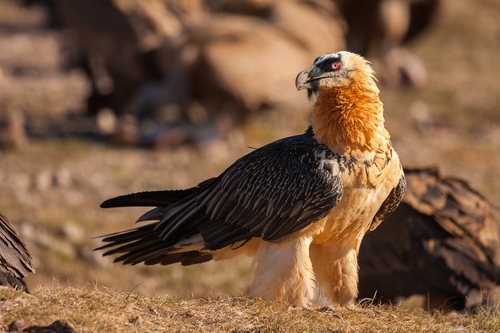
Bearded Vulture
The Bearded Vulture (*Gypaetus barbatus*), also known as the Lammergeier or Ossifrage, is a unique and majestic bird of prey. Unlike most vultures, it doesn't have a bald head. Instead, it boasts a distinctive 'beard' of black feathers. It plays a critical ecological role as a bone-eating specialist, consuming the remains that other scavengers cannot. This behavior reduces the spread of disease and recycles nutrients. The Bearded Vulture holds cultural significance in many mountainous regions, often symbolizing power, freedom, and connection to the natural world.
100-125 cm
Length
235-280 cm
Wingspan
Near Threatened
Conservation Status
Distribution
Found in mountainous regions across Eurasia and Africa, including the Pyrenees, Alps, Caucasus, Himalayas, and Ethiopian Highlands. It has a fragmented distribution due to specific habitat requirements.
Lifespan
Typically 20-25 years in the wild, but can live over 40 years in captivity.
Bearded Vulture's Habitat
Habitat Types
High-altitude mountains, Cliffs, Gorges, Steep slopes
Climate Zones
Temperate, Alpine
Adaptations
Adapted to cold, high-altitude environments with strong wings for soaring on thermals. Their feathered head and neck protect them from the cold, unlike most other vultures.
Variations
Several subspecies are recognized, with subtle variations in plumage and size across their range.
Appearance
Breeding Plumage
Adults have buff-orange underparts and dark gray upperparts. The orange color comes from bathing in iron-rich dust and mud. Juveniles are darker overall.
Seasonal Feather Changes
Minimal seasonal variation, but the intensity of the orange coloration can vary.
Sex Based Plumage Differences
Minimal sexual dimorphism, although females may have slightly more intense coloration.
Notable Features
Distinctive 'beard' of black feathers under the beak, Red eye-ring, Feathered head and neck (unlike most vultures), Large, powerful talons
Diet and Feeding
Primary Foods
Bones, Bone marrow, Small amounts of flesh and skin
Foraging Behavior
Soars over mountainous terrain searching for carcasses. Known for its unique bone-dropping behavior, where it carries bones high in the air and drops them onto rocks to shatter them into smaller, edible pieces.
Specializations
Highly acidic stomach to digest bones. Also has a long, raspy tongue to extract marrow.
Seasonal Diet Variations
Diet remains relatively consistent year-round, but may include more small prey items during the breeding season when feeding chicks.
Behavior
Social Structure
Generally solitary or found in pairs, although they may congregate at large carcasses.
Communication
Whistles and hisses, Visual displays, such as wing postures
Migration
Generally non-migratory, but may make altitudinal movements in response to food availability or weather conditions.
Territorial or Group Behaviors
Highly territorial during the breeding season, defending their nesting site and surrounding foraging areas.
Conservation
Threats
Poisoning (both intentional and unintentional), Habitat loss and degradation, Collisions with power lines, Human disturbance
Protection Programs
Reintroduction programs in the Alps and other areas, Monitoring of populations and breeding success, Public awareness campaigns, Legal protection in many countries
Local National Laws
Protected under various national and international laws, including CITES Appendix II.
Population Trend
Slightly Increasing, although populations remain fragmented and vulnerable.
Population Estimates
Estimated global population is around 1,300-6,700 mature individuals.
Interesting Facts
They are the only bird species that specializes in eating bones.
Their diet consists of up to 90% bone matter.
They deliberately stain their feathers with iron oxide.
This gives them their distinctive orange coloration, and may be a status signal.
They can swallow bones up to 25 cm long and 4 cm wide.
Their highly elastic esophagus and powerful stomach acids allow them to digest these large bone fragments.
They have been observed using tools.
Some individuals have been seen using small stones to help break open eggs.
Faqs about Bearded Vulture
Are Bearded Vultures dangerous to humans?
No, Bearded Vultures are scavengers and pose no threat to humans. They are shy and avoid human contact.
Why do they drop bones?
They drop bones from great heights onto rocks to shatter them, making it easier to access the nutritious bone marrow.
Where can I see a Bearded Vulture?
They are found in mountainous regions of Europe, Asia, and Africa. The Alps, Pyrenees, and Himalayas are some of the best places to see them.
What is the meaning of their other name, Ossifrage?
Ossifrage comes from latin and means 'bone breaker'. It is because of the Bearded Vulture's habit of breaking bones by dropping them from a great height.
Copyright @ Nature Style Limited. All Rights Reserved.
 English
English